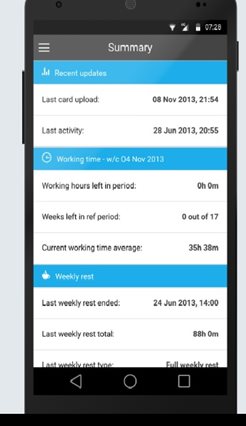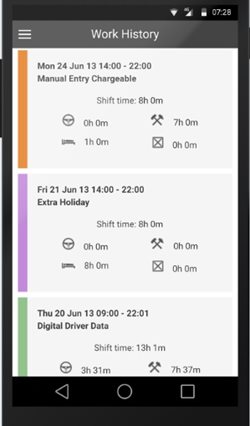The Driverfta App is a brand new feature that enables the driver to view their drivers’ hours in two ways.
The first is to see information through the forward looking hours screen, showing the driver, the hours they are allowed to do without causing infringements. Information shown includes:
Recent updates
- Date and time of last card upload
- Date and time of last activity
Working time
- Working hours left in reference period
- Weeks left in reference period
- Current working time average
Weekly rest
- Last weekly rest ended (date and time)
- Last weekly rest total
- Last weekly rest type
- Next weekly rest due (date and time)
Drivers’ hours
- Number of reduced rests available
- Number of drive extensions available
- Amount of driving this week
- Start time of next shift not before
The second way to view drivers’ hours is through the work history screen. This will show the following information:
As a default the last 2 weeks of information received by FTA including Digital, tachograph chart and information manually added to Visionfta will be reported on and will include:
- Type of activity
- Date of activity
- Start and end time of shift
- Vehicle reg (where available)
- Total shift time
- Summary total of each activity
- Details of any infringements.
You can download more than 2 weeks information by swiping the screen. The app will download a further 2 weeks each time the screen is swiped.
For more information contact tachosales@fta.co.uk


My name is Wyn Skyrme, a Vehicle Inspection Engineer specialising in HGV and PSV training and vehicle inspections. In my 32 years engineering experience I have been to many places, however my trip in early September to the Falkland Islands Government (Islas Malvinas) has been one to remember.

The Falkland Islands, a remote South Atlantic archipelago, is a British overseas territory. With rugged terrain and cliff-lined coasts, its 778 islands and islets are home to sheep farms and abundant birdlife. The capital, Stanley, sits on East Falkland, the largest island. The city's Falkland Islands Museum has themed galleries devoted to maritime exploration, natural history, the 1982 Falklands War and other subjects.
My goal to deliver HGV training to the staff of the plant and vehicle department and demonstrating best practice on UK legislation and enforcement started by a long but interesting journey. Travelling to the Falkland Islands consists of a split journey flight from Brize Norton RAF Airbase in Oxfordshire, flying out in one of their civilian transport planes known internally as an air tanker. On arrival, a high security checking-in procedure is carried out on all passengers and military staff followed by a flight of around 9 hours to the service base at the Ascension Island down in the South Atlantic. Ascension Island is an isolated volcanic island in the equatorial waters of the South Atlantic Ocean, around 1,600 kilometres (1,000 miles) from the coast of Africa and 2,250 kilometres (1,400 miles) from the coast of Brazil, which is roughly midway between the horn of South America and Africa. From here we flew another 9 hours to Mount Pleasant Airbase on the Falkland Islands. I estimated my total journey travelled around 26 hours.
On arrival I was met by the FIG Workshop Manager, Mr Ralph Harris, who co-ordinates the Government vehicle maintenance and operations on the islands. From there we travelled around 50 km on unmetalled roads in a temperature of minus five degrees celcius with a 30 mph wind (making it feel like minus 20). Speeds on these roads are maximum 40 mph and 25 mph in local areas. The roads have extremely large and frequent potholes which make 40mph feel rather excessive for the conditions. The roads on the island are maintained at Government expense and are constantly being regraded and repaired due to the islands maintenance programme. This being one of the reasons for being here - to identify maintenance strategies for HGV vehicles used for low mileage in hard and sometimes arduous conditions.
On arrival into Stanley I had an introduction to the FIG workshop staff and environment; a well-established place with all equipment readily available to carry out vehicle maintenance. Due to the remote position of the Island equipment and parts need to be in stock as delivery schedules from the UK to the Island can be time exhaustive.
Vehicles on the island are that of UK specification, although without the complication of current Euro standards generally vehicles that are built for the Middle East countries Euro 3 are ordered, as these have less of the electronics and legislative restrictions we have in the UK. No annual or vehicle testing or form of standards are in place on the islands, as described in the tyre law it is stated that tyres 'must be made of rubber and be of pneumatic inflation!'
The week I was there I trained all nine workshop staff and the workshop closed for the week. We carried out the full training course from legislation and enforcement within the UK, moving on to vehicle component assessment and defect reporting - updating their knowledge on how and why we have a documented DVSA produced standards manual within the UK. This was a mixture of classroom training and practical sessions working through pre-use checks, personal safety awareness, vehicle familiarisation and safety procedures whilst working in a workshop environment. Training the engineers to UK tandards on the island not only achieves getting the message across about the importance of vehicle maintenance standards, but also it’s about the voices of the world and sharing experiences and knowledge between already knowledgeable candidates. On closer investigation I needed to inspect the key areas of what they really wanted out of the training and diversified my knowledge and advice to educate in these areas. We found from early vehicle inspection that the wear that is abnormal for vehicles that would be used under normal operating conditions was apparent. The constant build-up of mud and snow gets into the operating areas of these vehicles and it is not uncommon for the heavier end of the fleet to have steering components and brakes overhauled and linings changed more frequently than that of trucks that operate in the UK. This was identified and staff were advised that a monitoring process should be implemented and identified on their inspection reporting, It would benefit all staff at an early stage of inspection to identify if a component will become in excess of tolerance before its next inspection.
We finally close the week up with assessment exam papers covering all the context of the training information presented over the week. Then a workshop assessment inspecting the vehicle to the routine presented, finally carrying out a functional brake test in both laden and unladen conditions on their roller brake tester in the workshop, calculating the results and comparing the important parameters that need to be met when carrying out vehicle brake testing.
I feel I have achieved in getting the message across in raising standards and the importance of vehicle inspections to UK standards, to all candidates. Delegates appeared to understand their responsibilities in continuing to move forward and improve the level of standards in all areas for road vehicles used in the Falkland Islands - my job done!
For me? Onwards and upwards back home to South Wales 30 hours later.